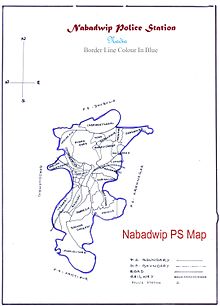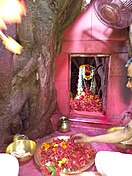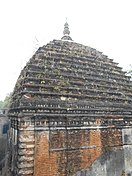world.wikisort.org - India
Nabadwip(নবদ্বীপ) (/ˌnæbəˈdwiːp/), anciently Nadia or Nudiya, is a heritage city in Nadia district in the Indian state of West Bengal. It is regarded as a holy place by Hindus, and is the birthplace of the Lord Chaitanya Mahaprabhu. Famous for Rass festival where city is enlited with lights, dieties of God and goddesses are made on each corner of Nabadwip town. Hundreds of people gather to this small town on the occasion of raas utsab. Located on the western bank of the Hooghly River, it is considered to have been founded in 1063 CE, and served as the old capital of the Sena dynasty. A center of learning and philosophy in medieval India, the city is still noted for its traditional Sanskrit schools.[2] The Navya Nyaya school of logic reached its peak with the efforts of some well known contemporary philosophers of Nabadwip. The great Vaishnava saint, social reformer and an important figure of the Bhakti movement, Chaitanya Mahaprabhu (1486–1534) was born here. It was after Chaitanya Mahaprabhu's birth that Nabadwip became an important center of pilgrimage for the Vaishnavas worldwide as well as for Hindus in general. Many who follow Gaudiya Vaishnavism visit Nabadwip to celebrate the auspicious birthday day of Shri Mahaprabhu, which, as per lunal calculations, occurs on Phalguni Purnima (i.e. on the Full moon day of February–March). This day is commonly known as Gaura-purnima.[3] Aside from this, Nabadwip is visited for various other festivals like Dol Jatra and Rash purnima.
This article may require cleanup to meet Wikipedia's quality standards. The specific problem is: Improper english. (June 2013) |
Nabadwip | |
|---|---|
City | |
Clockwise from top: Chaitanya Mahaprabhu in Dhameswar Mahaprabhu Temple, Dumureshbori Mata, Old Mahaprabhu Temple, Boat over River Ganges in Nabadwip, Maa Porama, Buro Shiv | |
| Nickname(s): Oxford of East Spiritual Capital of The World | |
 Nabadwip Location in West Bengal, India  Nabadwip Nabadwip (India) | |
| Coordinates: 23.42°N 88.37°E | |
| Country | India |
| State | |
| District | Nadia |
| Government | |
| • Type | Municipality |
| • Body | Nabadwip Municipality |
| Area | |
| • City | 9.81 km2 (3.79 sq mi) |
| Elevation | 14 m (46 ft) |
| Population (2011) | |
| • City | 125,543 |
| • Density | 13,000/km2 (33,000/sq mi) |
| • Urban | 175,474 |
| Time zone | UTC+5:30 (IST) |
| PIN | 741302 |
| Telephone code | 03472 |
| Vehicle registration | WB 52 |
| Lok Sabha constituency | Ranaghat |
| Vidhan Sabha constituency | Nabadwip |
| MLA | Pundarikakhya Saha |
| MP | Jagannath Sarkar |
| Website | nabadwipmunicipality.in |
| Birth Place of Chaitanya Mahaprabhu[1] | |
The Bhagirathi river originally flowed down the west of Nabadwip in the past, forming a natural boundary between the districts of Purba Bardhaman and Nadia. With time it has shifted its course to where it is at present, cutting the city off from the rest of the Nadia district.
Etymology
The name of the city is derived from the conjugation of the Bengali words /naba/ (new) and /dwipa/ (island) meaning New-island. In the down stream of the river Ganges, the alluvial deposits carried over during its course that starts at the Himalayas, were gradually deposited, forming a new island which is present day's Nabadwip. The name Nabadwip and Nadia has the same connotation of the same geographical location flanked at west and north by the Ganges at earlier times.[4] Kabi Karnapur used Nabadwip as Nabīna dbīpaṁ (Bengali: নবীন দ্বীপং), mean New Island in his book Chaitanya Charitamritam[5][6]
The claim that the name Nabadwip refers to an area comprising nine islets has no ground. There are many historical references in this respect. Actually the misconception around the nomenclature of the name "Nabadwip" arose since the publication of the book "Bhakti Ratnakar" of Narahari Chakraborty. Hence "Nabadwip" i.e. nine islands, namely Antardwip, Simantadwip, Rudradwip, Madhyadwip, Godrumdwip, Ritudwip, Jahnudwip, Modadrumdwip, and Koladwip. However again, it is to mention that all these islands are loosely scattered over a vast geographical area that the Historians do not approve of the idea as being "Nabadwip".[7]
History
Although significant examples of the history of Nabadwip have been found since the Sen dynasty, various historians have been referring to Nabadwip in the Pala period and the Shura dynasty.[8] English historian John Clark Marshman mentioned Nabadwip as the capital of Adishur.[9]
Sena era
It is known from the Deopara stone slab of Rajshahi district that Raja Samanta Sena, a resident of Karnataka, lived in the Ganges-Pulin in his last years when he was defeated by his tenants and zamindars. According to the eminent historian Harprasad Shastri, Samanta Sen lived on the shores of Bhagirathi, probably in Nabadwip in his last years.[10] Prior to Gour, Nabadwip was the capital of Sena dynasty during the reigns of Ballal Sen and Lakshman Sen. They ruled Bengal from here in the period from 1159 to 1206. The Ballal Dhipi in the Bamanpukur area adjacent to Nabadwip, which is associated with the history of Sen dynasty, has been protected by the Archaeological Survey of India.[11] During the reign of Lakshman Sen, in 1202 AD, Bakhtiyar Khalji invaded and plundered Nabadwip and defeated Lakshman Sen, a victory that led to Muslim rule in Bengal. At that time the prosperity of Nabadwip was particularly damaged. During the Muslim rule, various temples, golden monasteries and idols of Bengal and Nabadwip were destroyed.[12]
Chaitanya era
The birth of Chaitanya Mahaprabhu is an important chapter of the fifteenth century. With the advent of Chaitanya Mahaprabhu, Vaishnava culture was well established in Nabadwip. However, even before the birth of Mahaprabhu, during the reign of Jalaluddin Fateh Shah (1481–87), royal fear appeared in Nabadwip. The ruling society and the Brahmin society obstructed the spread of Vaishnava culture in Nabadwip at that time.[13] Many Brahmin scholars and common people had to leave Nabadwip at that time due to the oppression of the king. However, when Chand Kazi, the then ruler of Nabadwip, issued an order to the Vaishnava community to stop chanting, Mahaprabhu went to Kazi's house with his companions and convinced the Kazi to allow the chanting, which is the first instance of civil disobedience movement in the history of India.[14] During Chaitanya and later, various Pandits-Sadhaks-Vidyalankars and Sanskrit Pandits were born in Nabadwip. During the period of Chaitanya, Basudev Sarvabhauma, Raghunath Shiromani, Raghunandan etc. and later Krishnananda Agamavagisha, Buno Ramnath etc., Nabadwip became the main center of Sanskrit practice and learning.[15] At the time of Raja Rudra Roy, there were four thousand students and six hundred professors teaching in Nabadwip, leading to its nickname as the "Oxford of Bengal".[16]
Next centuries
Buno Ramnath, Shankara Tarkabagish and other scholars and logicians made the name of Nabadwip famous in the eighteenth century. Shakti worship spread in Nabadwip during the time of Raja Krishnachandra of Nadia royal family. During the reign of Raja Krishnachandra Roy and later Raja Girish Chandra, the popularity, glory and pomp of Shakta Rash increased. Various temples and idols were established in that time.[17]
Geography
R: temple, F: facility, H: historical site
Owing to space constraints in the small map, the actual locations in a larger map may vary slightly
Demographics
In the 2011 census, Nabadwip Urban Agglomeration had a population of 175,474, out of which 90,810 were males and 84,664 were females. The 0–6 years population was 8,388. In education section, total literates in Nabadwip city are 102,793 of which 55,569 are males while 47,224 are females. Average literacy rate of Nabadwip city is 87.75 percent of which male and female literacy was 91.14 and 84.07 percent. Total children (0-6) in Nabadwip city are 8,388 as per figure from Census India report on 2011. There were 4,329 boys while 4,059 are girls. The child forms 6.68% of total population of Nabadwip City.[18]
The following municipality and census towns were part of Nabadwip Urban Agglomeration in 2011 census: Nabadwip (M), Char Maijdia (CT), Char Brahmanagar (CT), Bablari Dewanganj (CT), Tiorkhali (CT), Gadigachha (CT) and Majdia.[19]
As of 2001[update] India census,[20] Nabadwip had a population of 115,036. Males constitute 51% of the population and females 49%. Nabadwip has an average literacy rate of 75%, higher than the national average of 59.5%: male literacy is 80%, and female literacy is 70%. In Nabadwip, 9% of the population is under 6 years of age.
Religion
Religion in Nabadwip (2011)[21]
Hinduism is majority religion in Nabadwip city with 98.97% followers. Islam is second most popular religion in city of Nabadwip with approximately 0.79% following it. In Nabadwip city, Christianity is followed by 0.04%, Jainism by 0.00%, Sikhism by 0.01% and Buddhism by 0.00%. Around 0.01% stated Other Religion, approximately 0.18% stated No Particular Religion.
Civic administration
Police station

Nabadwip police station has jurisdiction over Nabadwip municipality and the Nabadwip CD block.[22][23] The total area covered by the police station is 102.94 km2 and the population covered is 260,843 (2001 census).[24]
Education


There are a total of 18 high and higher secondary schools in Nabadwip, Notables among them are Nabadwip Bakultala High School (1875), Nabadwip Hindu School (1873), Nabadwip Siksha Mandir (H.S), R.C.B Saraswatmandir, Jatiya Vidyalaya, Tarasundari Girls High School, Nabadwip Bakultala Girls High School, Nabadwip Balika Vidyalaya, Sudarshan High School and Techno India School etc. There is a college namely Nabadwip Vidyasagar College (in the name of the Great Social Reformer and the Father of Bengali Prose) affiliated under University of Kalyani.
Climate
In summer, i.e. from April to June, the weather remains hot and temperature ranges from maximum of 35 °C to minimum of 26 °C. Monsoon season prevails during beginning-June to mid-September. Also retrieving monsoon from mid-October till mid-November.[25]
The weather is quite pleasant, the summers and winters are moderate. The level of moisture increases during summers.
Festival
Many festivals are celebrated in Nabadwip throughout the year. Among them Shakta Rash, Dol Purnima Ratha Yatra are the most popular religious festivals in Nabadwip. Other major festivals are Kali Puja, Durga Puja, Gaura-purnima (the birthday of Chaitanya Mahaprabhu), Shiber Biye, Gajan, Pohela Boishakh, Jhulan Purnima etc. An extinct festival of Nabadwip is Dhulōṭa (Bengali: ধুলোট). It is the general conferences of Kirtaniyas, occurred in month of Magh.[26] Typically, it is a thirteen-day-long Sankirtana, performed by renowned Kirtaniyas from all over Bengal who gathered in Nabadwip in that time.[27]
Shakta Rash
Shakta Rash is the most celebrated age-old festival of Nabadwip, celebrated thirty-five days after the autumnal Durga puja celebration, or fifteen days after Kali puja in Kartik Purnima. The main feature of the festival is to make huge idols of different types of goddesses and to worship Shakti. After the patronize of Raja Krishnachandra Roy and mainly Girish Chandra Basu, Nabadwip Shakta Rash became more popular and glorious.[28]
Rath Yatra
Although Ratha Yatra is the main festival of Odisha, still Nabadwip have a pride of Ratha Yatra because of Chaitanya Mahaprabhu. Nearly 20-25 Ratha Chariots are bloom in this occasion. Here in Nabadwip one can found some exceptions like full hand idols of Lord Jagannatha. Here another speciality is a fruit called "Notkona" which is specially found in this eve, mainly brought from Assam. This Fruit is a vital part of Eastern part of Bengali.[29]
Transport
Rail services
Nabadwip Dham railway station is the main railway station of Nabadwip. The railway inaugurated in 1913. It is situated 105 km from Howrah on the Bandel-Katwa Branch Line.[30] Nabadwip Dham Railway Station is seventh longest railway station of India (2362 ft). Bishnupriya railway station is another Halt station of Nabadwip, 107 km from howrah junction and 38 km from katwa junction.
Nabadwip Dham is 65 km from Bandel,105 km from Howrah and 112 km from Sealdah on the Bandel-Katwa-Azimganj section of Eastern Railway.[31] It has very good railway communication with North Bengal, Assam, Bihar, Odisha and Kolkata.[32]
Bus services
There is a good bus services in Nabadwip. From Nabadwip bus stand, it connect with Krishnanagar, Shantipur, Phulia, Ranaghat, Chakdaha, Nadanghat, Kusumgram, Bardhaman, Karimpur, Samudragarh, Memari, Tarapith Via Katwa etc. A long-distance bus services like Durgapur, Asansol, Tarakeswar, Siliguri, Dinhata Via Berhampur, Maldah, Coochbehar, Bolpur, Puruliya, Bankura, Suri, Gangarampur provided here.
References
- Chattopadhyay, Nripendra Krishna (1961). Sri Sri Chaitanya Charitamrita.
- "Navadwip". Encyclopædia Britannica.
- Ro'sel, J.A. (1990). "The Evolution And Organization Of Pilgrimage To Jagannstha At Purt".
{{cite journal}}: Cite journal requires|journal=(help) - Mandal, Mrityunjoy (2013). Nabadwiper Itibritta. Nabadwip: Nabadwip Sahityo Somaj. p. 59.
- Mandal, Mrityunjoy (2013). Nabadwiper Itibritta. Nabadwip: Nabadwip Sahityo Somaj. p. 58.
- Kabi Karnapur, Sri Chaitanya Charitam, 6|23
- Mandal, Mrityunjoy (2013). Nabadwiper Itibritta. Nabadwip: Nabadwip Sahityo Somaj. p. 62.
- Smith, vincent A. (1923). The Oxford History Of India,ed.2. pp. 184–185.
- Marshman, John Clark (1853). Marshman's History of Bengal, in Bengali.
- Sastri Haraprasad (1896). A School History Of India. p. 34.
- Rāṛhī, Kānticandra (2004). Nabadvīpa-mahimā (in Bengali). Nabadvīpa Purātattva Parishada. p. 55.
- Jūzjānī, Minhāj Sirāj (1881). Tabaḳāt-i-Nāṣirī: A General History of the Muhammadan Dynasties of Asia, Including Hindūstān, from A.H. 194 [810 A.D.], to A.H. 658 [1260 A.D.], and the Irruption of the Infidel Mug̲h̲als Into Islam. Asiatic Society of Bengal. p. 559.
- Jaẏānanda; Majumdar, Bimanbehari; Mukhopadhyay, Sukhamay (1971). Jayānandaʼs Caitanya-maṅgala = Jaẏānanda biracita Caitanyamaṅgala. Calcutta: The Asiatic Society. OCLC 499557268.
- "ধর্মের বেড়াজাল ভেঙে সাম্যের ধারণার প্রতিষ্ঠা". anandabazar.com (in Bengali). Retrieved 18 June 2020.
- Mookerji, Radhakumud (1989). Ancient Indian Education: Brahmanical and Buddhist. Motilal Banarsidass Publ. ISBN 978-81-208-0423-4.
- Cotton, Sir Evan (1980). Calcutta, Old and New: A Historical and Descriptive Handbook to the City. General Printers & Publishers. p. 1.
- Roy, Alok Ed (1958). Sekaler Darogar Kahini Ed. 2nd.
- "Urban Agglomerations/Cities having population 1 lakh and above" (PDF). Provisional Population Totals, Census of India 2011. Retrieved 21 October 2011.
- "Provisional Population Totals, Census of India 2011" (PDF). Constituents of Urban Agglomeration Having Population Above 1 Lakh. Census of India 2011. Retrieved 18 October 2020.
- "Census of India 2001: Data from the 2001 Census, including cities, villages and towns (Provisional)". Census Commission of India. Archived from the original on 16 June 2004. Retrieved 1 November 2008.
- "Nabadwip Religion 2011". Retrieved 22 March 2017.
- "District Statistical Handbook 2014 Nadia". Table 2.1. Department of Planning and Statistics, Government of West Bengal. Retrieved 7 October 2020.
- "Nadia District Police". Police Unit. West Bengal Police. Retrieved 17 May 2017.
- "Nabadwip Police Station Details". Nadia Police. Archived from the original on 29 March 2016. Retrieved 17 May 2017.
- "Maps, Weather, and Airports for Krishnanagar, India". www.fallingrain.com. Retrieved 5 April 2018.
- Mandal, Mrityunjoy (2013). Nabadwiper Itibritta. Nabadwip: Nabadwip Sahityo Somaj. p. 142.
- Bhatia, Varuni (2017). Unforgetting Chaitanya: Vaishnavism and Cultures of Devotion in Colonial Bengal. Oxford University Press. p. 80. ISBN 978-0-19-068624-6.
- Basu, Girish Chnadra (1888). Sekaler Daroga Kahini. kolkata: Pustak Biponi. pp. 34–35.
- বন্দ্যোপাধ্যায়, দেবাশিস. "আজ উল্টোরথ, নবদ্বীপে বিরলদৃষ্ট জগন্নাথ থাকেন নিভৃতেই". anandabazar.com. Retrieved 5 April 2018.
- Railway local time table
- Eastern Railway time table.
- "India Rail Info: A Busy Junction for Travellers and Rail Enthusiasts". indiarailinfo.com. Retrieved 5 April 2018.
External links
- Nabadwip Municipality
- Department of Tourism by West Bengal Government
- Nabadwip Puratattva Parishad
- Nabadwip Encyclopædia Britannica entry
 Nabadwip travel guide from Wikivoyage
Nabadwip travel guide from Wikivoyage Quotations related to Nabadwip at Wikiquote
Quotations related to Nabadwip at Wikiquote
На других языках
[de] Nabadwip
Nabadwip (bengalisch: .mw-parser-output .Beng{font-size:110%}নবদ্বীপ, Nabadbīp) ist eine Großstadt mit etwa 125.000 Einwohnern im Distrikt Nadia im indischen Bundesstaat Westbengalen.- [en] Nabadwip
[ru] Набадвип
Набадвип, или Навадви́п(а) (бенг. নবদ্বীপ, англ. Nabadwip) — город в округе Надия индийского штата Западная Бенгалия. Также — историческая область в месте слияния рек Ганги и Джаланги, с центром в городе Навадвипа. «Навадвипа» в переводе с бенгальского языка означает «девять островов». Эти острова называются Антардвипа (Маяпур), Симантадвипа, Рудрадвипа, Мадхьядвипа, Годрумадвипа, Ритудвипа, Джахнудвипа, Модадрумадвипа и Коладвипа. Более 500 лет назад здесь прошли «божественные игры» вайшнавского святого Чайтаньи, который в традиции гаудия-вайшнавизма почитается как совместное аватара Радхи и Кришны. Ежегодно Навадвипу посещают множество паломников, приезжающих со всего мира. Особенной популярностью пользуется фестиваль Гаура-пурнима, накануне которого проводится Навадвипа-мандала-парикрама — паломничество по девяти островам Навадвипы.[1]Другой контент может иметь иную лицензию. Перед использованием материалов сайта WikiSort.org внимательно изучите правила лицензирования конкретных элементов наполнения сайта.
WikiSort.org - проект по пересортировке и дополнению контента Википедии










